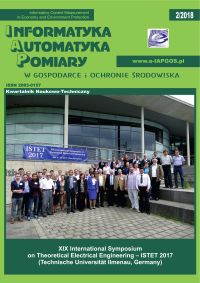ROZPROSZONA METODA DO SYMULACJI STANÓW PRZEJŚCIOWYCH DYNAMICZNIE UWZGLĘDNIAJĄCA DODATKOWE WYNIKI AUTONOMICZNYCH AGENTÓW PROGRAMOWYCH
##plugins.themes.bootstrap3.article.sidebar##
Open full text
Numer Tom 8 Nr 2 (2018)
-
MODELOWANIE STANÓW PRZEJŚCIOWYCH MASZYN PRĄDU PRZEMIENNEGO Z UWZGLĘDNIENIEM EFEKTÓW DRUGIEGO RZĘDU
Olga Korolova, Juan de la Torre Cubillo, Bernd Ponick4-8
-
ANALIZA PRZECIWRÓWNOLEGŁEGO OBWODU MEMRYSTOROWEGO
Valeri Mladenov, Stoyan Kirilov9-14
-
ZAAWANSOWANY MODEL MEMRYSTORA ZE MODYFIKOWANYM OKNEM BIOLEK ORAZ EKSPONENTĄ ZALEŻNĄ OD NAPIĘCIA
Valeri Mladenov, Stoyan Kirilov15-20
-
MODELOWANIE MATEMATYCZNE I SYSTEM STEROWANIA BUDYNKIEM NIEMAL ZEROENERGETYCZNYM
Ildar A. Sultanguzin, Hannes Toepfer, Ivan D. Kalyakin, Alexandr V. Govorin, Ekaterina V. Zhigulina, Sergey Yu. Kurzanov, Yury V. Yavorovsky21-24
-
CZĘSTOTLIWOŚCIOWY KONWERTER PWM ZE STEROWANIEM W OTWARTEJ PĘTLI
Malte John, Axel Mertens25-29
-
POLE MAGNETYCZNE WSPÓŁOSIOWYCH KWADRATOWYCH CEWEK ZAMKNIĘTYCH W MATERIALE O WYSOKIEJ PERMEANCJI
Anamarija Juhas, Neda Pekaric Nad, Hannes H. Toepfer30-34
-
ROZPROSZONA METODA DO SYMULACJI STANÓW PRZEJŚCIOWYCH DYNAMICZNIE UWZGLĘDNIAJĄCA DODATKOWE WYNIKI AUTONOMICZNYCH AGENTÓW PROGRAMOWYCH
Matthias Jüttner, Sebastian Grabmaier, Jonas Rohloff, Desirée Vögeli, Wolfgang M. Rucker, Peter Göhner, Michael Weyrich35-38
-
MULTISENSORY DLA BIOSENSORÓW PEŁNOKOMÓRKOWYCH
Ingo Tobehn-Steinhäuser, Margarita Günther, Stefan Görlandt, Steffen Herbst, Heike Wünscher, Thomas Ortlepp, Gerald Gerlach39-41
-
NARZĘDZIA DO PORÓWNANIA WYNIKÓW PRACY ALGORYTMÓW SORTOWANIA
Larysa Gumeniuk, Vladimir Lotysh, Pavlo Gumeniuk42-45
-
ZMODYFIKOWANA, UZUPEŁNIONA TAKSONOMIA USTEREK W TOLERUJĄCYCH AWARIE SYSTEMACH CZASU RZECZYWISTEGO
Volodymyr Mosorov, Taras Panskyi, Sebastian Biedron46-49
-
ZASTOSOWANIE NADMIAROWOŚCI W PROTOKOLE LEACH
Volodymyr Mosorov, Sebastian Biedron, Taras Panskyi50-53
-
ANALIZA OBRAZÓW MEDYCZNYCH I STEREOSKOPOWYCH W SYSTEMIE E-MEDICUS
Tomasz Rymarczyk54-57
-
ANALIZA SKUTECZNOŚCI WYBRANYCH METOD SEGMENTACJI STRUKTUR ANATOMICZNYCH MÓZGU
Róża Dzierżak, Magdalena Michalska58-61
-
ANALIZA WŁAŚCIWOŚCI METROLOGICZNYCH SIATEK BRAGGA ZE STAŁYM I ZMIENNYM OKRESEM
Tomasz Zieliński, Piotr Kisała62-67
-
BADANIA PORÓWNAWCZE SPRAWNOŚCI UKŁADÓW DC/DC Z TRANZYSTORAMI SI IGBT ORAZ TRANZYSTORAMI SIC TYPU MOSFET
Karol Fatyga, Łukasz Kwaśny, Bartłomiej Stefańczak68-71
-
PROPOZYCJA ZARZĄDZANIA JAKOŚCIĄ NAPIĘCIA Z WYKORZYSTANIEM PODOBCIĄŻENIOWEGO PRZEŁĄCZNIKA ZACZEPÓW TRANSFORMATORA I KOMPENSATORA STATCOM
Bartłomiej Mroczek, Karol Fatyga72-78
-
OCENA RUCHU PALIWA W PROCESIE SPALANIA NA PODSTAWIE OBRAZU CYFROWEGO
Łukasz Pater79-82
-
NIELINIOWA ANALIZA SIECI ZBIERAJĄCYCH ENERGIĘ W ZAKRESIE RADIOWYM O WYSOKIM WSPÓŁCZYNNIKU DOBROCI Q
Christian Merz, Gerald Kupris83-86
Archiwum
-
Tom 10 Nr 4
2020-12-20 16
-
Tom 10 Nr 3
2020-09-30 22
-
Tom 10 Nr 2
2020-06-30 16
-
Tom 10 Nr 1
2020-03-30 19
-
Tom 9 Nr 4
2019-12-16 20
-
Tom 9 Nr 3
2019-09-26 20
-
Tom 9 Nr 2
2019-06-21 16
-
Tom 9 Nr 1
2019-03-03 13
-
Tom 8 Nr 4
2018-12-16 16
-
Tom 8 Nr 3
2018-09-25 16
-
Tom 8 Nr 2
2018-05-30 18
-
Tom 8 Nr 1
2018-02-28 18
-
Tom 7 Nr 4
2017-12-21 23
-
Tom 7 Nr 3
2017-09-30 24
-
Tom 7 Nr 2
2017-06-30 27
-
Tom 7 Nr 1
2017-03-03 33
-
Tom 6 Nr 4
2016-12-22 16
-
Tom 6 Nr 3
2016-08-08 18
-
Tom 6 Nr 2
2016-05-10 16
-
Tom 6 Nr 1
2016-02-04 16
##plugins.themes.bootstrap3.article.main##
DOI
Authors
matthias.juttner@ite.uni-stuttgart.de
sebastian.grabmaier@ite.uni-stuttgart.de
desiree.voegeli@ias.uni-stuttgart.de
peter.goehner@ias.uni-stuttgart.de
Abstrakt
W oparciu o autonomiczne agenty programowe zdolne do obliczania indywidualnych numerycznych problemów pola, przedstawiono rozproszoną metodę rozwiązywania stanów przejściowych pola. Agenty programowe działają na zasobach rozproszonych połączonych za pośrednictwem sieci i reprezentują środowisko obliczeń dynamicznych. Komunikacja i wymiana danych między wieloma agentami umożliwia ich współpracę i pozwala podejmować decyzje w oparciu o rozproszoną wiedzę ogólną. Jako unikalna charakterystyką jest fakt, że żadna jednostka centralna nie wpływa w żadnym momencie na proces rozwiązania. Przedstawiony przykład symulacji i jej oszacowany proces obliczeniowy dowodzi, że metoda umożliwia korzystanie z nadmiarowych zasobów.
Słowa kluczowe:
Bibliografia
Bíró O.: Edge element formulations of eddy current problems. Computer Methods in Applied Mechanics and Engineering 169(3-4)/1999, 391–405.
Celaya E.A., Aguirrezabala J.A., Chatzipantelidis P.: Implementation of an Adaptive BDF2 Formula and Comparison with the MATLAB Ode15s. Procedia Computer Science 29/2014, 1014–1026.
Emson C., Trowbridge C.: Transient 3D Eddy Currents Using Modified Magnetic Vector Potentials and Magnetic Scalar Potentials. IEEE Transactions on Magnetics 24(1)/1988, 86–98.
Gander M.J.: 50 Years of Time Parallel Time Integration. Multiple Shooting and Time Domain Decomposition Methods, Cham, Springer, 2015, 69–113.
Hairer E., Nørsett S.P., Wanner G.: Solving ordinary differential equations I. Nonstiff Problems, 2nd ed., Springer, Berlin 2009.
Hindmarsh A.C., Brown P.N., Grant K.E., Lee S.L., Serban R., Shumaker D., Woodward C.S.: SUNDIALS: Suite of nonlinear and differential/algebraic equation solvers. ACM Transactions on Mathematical Software 31(3)/2005, 363–396.
Jennings N.R.: On agent-based software engineering. Artificial Intelligence 117/1999, 277–296.
Jüttner M., Grabmaier S., Vögeli D., Rucker W.M., Göhner P.: Coupled Multiphysics Problems as Market Place for Competing Autonomous Software Agents. IEEE Transactions on Magnetics 53(6)/2017.
Moore P.K., Petzold L.R.: A stepsize control strategy for stiff systems of ordinary differential equations. Applied numerical mathematics 15(4)/1994, 449–463.
Zienkiewicz O.C., Emson C., Bettess P.: A novel boundary infinite element. International Journal for Numerical Methods in Engineering 19(3)/1983, 393–404.
##plugins.themes.bootstrap3.article.details##
Abstract views: 312
Licencja

Utwór dostępny jest na licencji Creative Commons Uznanie autorstwa – Na tych samych warunkach 4.0 Miedzynarodowe.






